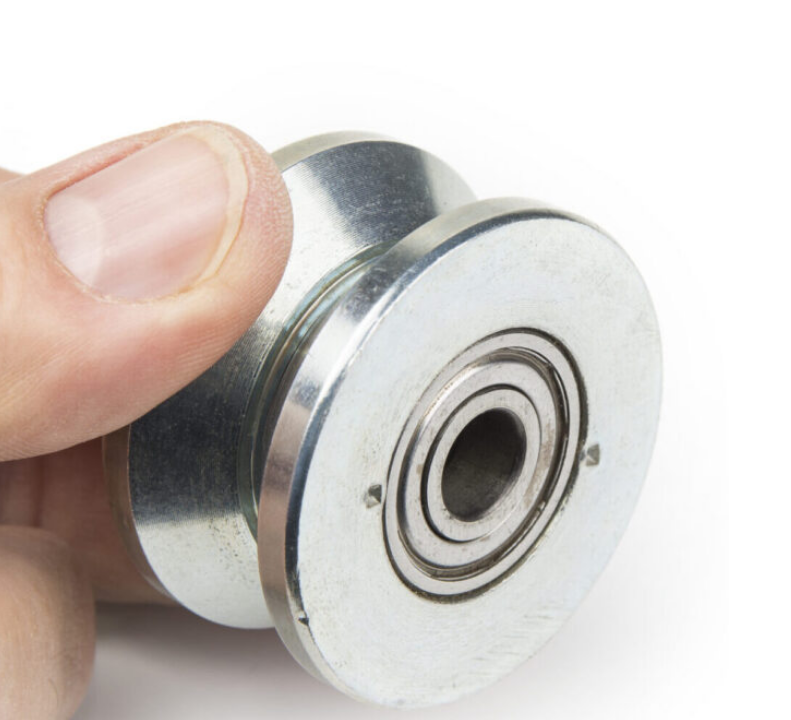Track roller linear guides: Two needs for lubrication

Many track-roller linear guides necessitate lubrication at two different points in their assembly:
Within the rolling-element rotary bearings at the heart of each track-roller wheel and
Along the linear track-roller raceway.
As with most any mechanical power-transmission devices, lubrication of these two critical areas extends the linear guide’s service life by minimizing or eliminating the corrosion of metal subcomponents as well as reducing friction and noise (and therefore wear).
Track-roller wheel-bearing lubrication
For the rolling-element rotary bearings at the heart of each track-roller wheel, industrial-grade mineral oil is most commonly used for lubrication with lithium soap grease where suitable. (In fact, lithium-soap grease is sometimes also applied to the raceway for shipping.) For very hot settings or axes required to bear especially heavy payloads, extreme-pressure or EP additives can prevent direct contact of mating wear surfaces as well as resist the detrimental effects of sliding surface contact.
As with any component that’s at its core a metal rolling-element rotary bearing, grease filling mustn’t exceed the recommended percentage of bearing’s free internal volume.
Track-roller raceway lubrication
The raceways of track-roller linear guides often obtain lubrication via wipers pre-integrated into the assembly’s carriage in some way. Where exacting lubrication parameters are essential to the machine axis’ operation, some manufacturers allow for carriages to be specified with lubrication wipers or oil designed for a given application — for example, with metal shields to ensure the delicate wiper elements withstand operation on machine-tool equipment.
Some manufacturers offer engineered caps to encase and therefore protect wheels while concurrently delivering lubrication to the raceway upon each axis stroke.
Often, the lubricant applicator itself takes the form of a felt cuboid loaded with oil. These rectangular prisms are either preloaded with enough oil to last the life of the machine or assembled to the carriage so that the end user can reload them with oil via a lubrication nipple during regular servicing. Though exceptions abound, small track-roller assemblies are more likely to be lubricated and sealed for life, while those destined to bear heavy loads often feature means and hardware to allow relubrication.
In fact, such servicing should take place at lubrication intervals defined by the linear-component supplier. While the exact interval may require definition by qualitative test runs, particularly dirty settings always necessitate more frequent and copious lubricant. Otherwise, raceway fretting, corrosion, and other issues will develop.
One last note: Where a piece of linear-motion equipment is destined for use in the food and beverage industry and there’s a possibility of incidental food contact, lubricant used on the raceway should be National Sanitation Foundation (NSF) Intl. H1 lubricant.
Grease versus oil track roller linear guide lubrication
The most suitable lubricant for the internal elements of a track-roller wheel depends on the bearing type it contains; the application’s parameters; how the track-roller linear guide is integrated into the larger machine; and the accessibility of the linear guide for potential relubrication.
Oil lubrication can creep into and carry heat out of contact zones; the latter is especially important on linear axes needing to make quick strokes. Oil also tends to offer exceptionally low friction and transport debris away from the working (contact) zones of the guide assembly. The main drawback of using oil is the way in which it necessitates special sealing.
In contrast, grease lubrication carries no debris or heat out of contact zones and can in some cases get pushed out of the very contact zones it’s meant to protect. However, grease requires almost no special retention elements. In fact, it tends to protect wheel assemblies in particular against the ingress of debris. It’s also a leading choice where an axis must deliver a long service life with little to no servicing. Where needed, ducts for the infrequent changing of grease may be included in the carriage assembly.
Though beyond the scope of this Design Guide, a third option for especially hot, corrosive, or otherwise challenging applications is track-roller carriage elements sporting assembly elements made of solid lubricant or oil-impregnated materials to wipe over or intermittently daub working surfaces with lubricating substances.
1.The news above mentioned with detailed source are from internet.We are trying our best to assure they are accurate ,timely and safe so as to let bearing users and sellers read more related info.However, it doesn't mean we agree with any point of view referred in above contents and we are not responsible for the authenticity. If you want to publish the news,please note the source and you will be legally responsible for the news published.
2.All news edited and translated by us are specially noted the source"CBCC".
3.For investors,please be cautious for all news.We don't bear any damage brought by late and inaccurate news.
4.If the news we published involves copyright of yours,just let us know.
Next Over a million bearings: Schaeffler Wind Power Standard ensures maximum reliability in wind turbines
BRIEF INTRODUCTION
Cnbearing is the No.1 bearing inquiry system and information service in China, dedicated to helping all bearing users and sellers throughout the world.
Cnbearing is supported by China National Bearing Industry Association, whose operation online is charged by China Bearing Unisun Tech. Co., Ltd.
China Bearing Unisun Tech. Co., Ltd owns all the rights. Since 2000, over 3,000 companies have been registered and enjoyed the company' s complete skillful service, which ranking many aspects in bearing industry at home and abroad with the most authority practical devices in China.




